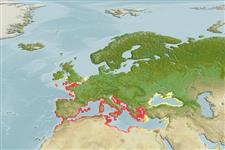Environment: milieu / climate zone / depth range / distribution range
Ecologia
marinhas; estuarina demersal; oceanódromo (Ref. 51243); intervalo de profundidade 10 - 35 m (Ref. 80021). Subtropical; 53°N - 30°N, 10°W - 42°E
Eastern Atlantic and theMediterranean and Black Sea; with dubious records from the Gulf of Suez (Ref. 80021).
Tamanho / Peso / Idade
Maturity: Lm ? range ? - ? cm
Max length : 15.7 cm TL macho/indeterminado; (Ref. 30504); idade máx. registrada: 10 anos (Ref. 4696)
Occurs in the intertidal zones, among rocks, weeds and pools where the water is usually brackish (Ref. 4343, 5299). Occasionally recorded in freshwater, but there are no documented records of actual occurrence in European freshwaters (Ref. 59043). Macrobenthos feeder on hard substrates (Ref. 92840), feeds on green algae (Enteromorpha), crustaceans (amphipods, crabs), polychaetes, and insects (Ref. 4696).
Benthic spawner.
Miller, P.J., 1986. Gobiidae. p. 1019-1085. In P.J.P. Whitehead, M.-L. Bauchot, J.-C. Hureau, J. Nielsen and E. Tortonese (eds.) Fishes of the North-eastern Atlantic and the Mediterranean. Volume 3. UNESCO, Paris. (Ref. 4696)
Status na Lista Vermelha da UICN (Ref. 130435: Version 2024-1)
Ameaça para os humanos
Harmless
Uso pelos humanos
Pescarias: pouco comercial; peixe esportivo: sim
Ferramentas
Relatórios especiais
Baixar XML
Fontes da internet
Estimates based on models
Preferred temperature (Ref.
123201): 13.8 - 19.6, mean 18 °C (based on 544 cells).
Índice de diversidade filogenética (Ref.
82804): PD
50 = 0.5000 [Uniqueness, from 0.5 = low to 2.0 = high].
Bayesian length-weight: a=0.00912 (0.00727 - 0.01143), b=3.11 (3.07 - 3.15), in cm total length, based on LWR estimates for this species (Ref.
93245).
Nível Trófico (Ref.
69278): 3.0 ±0.39 se; based on food items.
Resiliência (Ref.
120179): médio(a), tempo mínimo de duplicação da população 1,4 - 4,4 anos (K=0.22; tm=2-3; tmax=10).
Fishing Vulnerability (Ref.
59153): Low vulnerability (10 of 100).
Nutrients (Ref.
124155): Calcium = 160 [77, 360] mg/100g; Iron = 1.22 [0.66, 2.33] mg/100g; Protein = 18.5 [16.6, 20.1] %; Omega3 = 0.365 [0.160, 0.679] g/100g; Selenium = 15.2 [7.7, 31.1] μg/100g; VitaminA = 22.7 [7.0, 64.4] μg/100g; Zinc = 1.45 [0.98, 2.16] mg/100g (wet weight);
